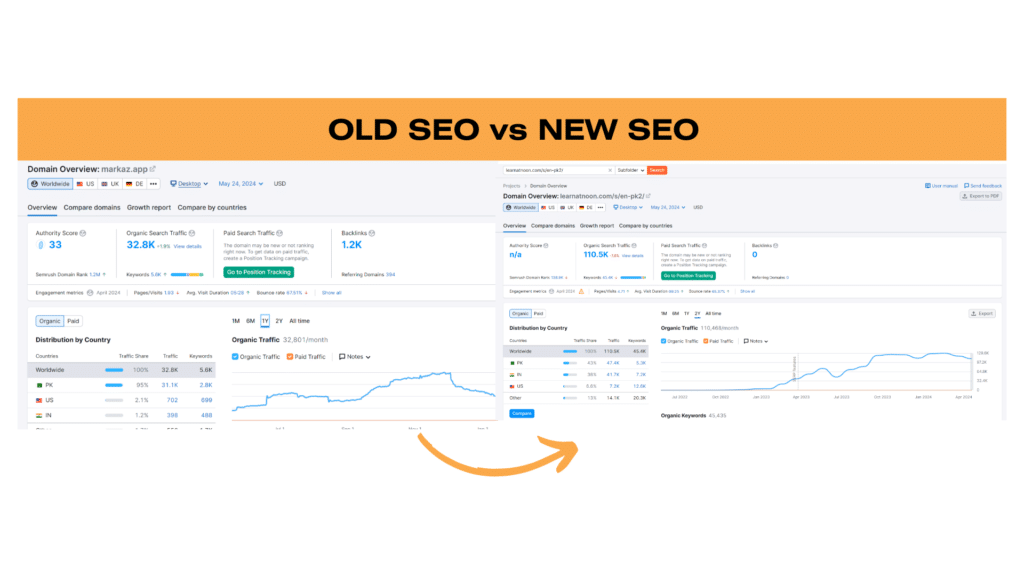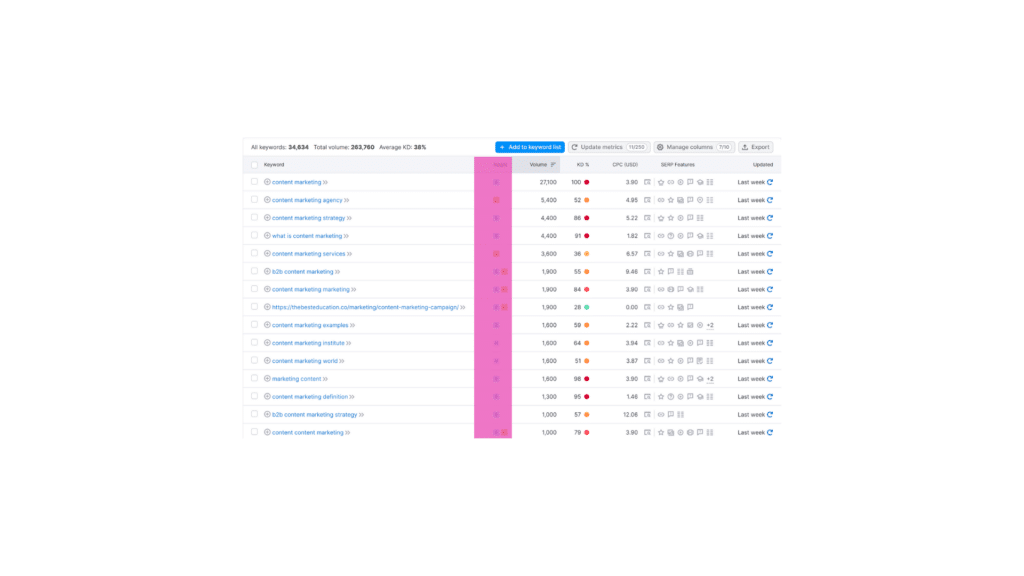Looking for SEO mastery in 2024? You’re after swift results and impeccable website performance, aren’t you? Yet, there’s more to it than meets the eye.
Beyond mere outcomes, it’s about partnering with an SEO powerhouse equipped with up-to-date knowledge of cutting-edge tools, current trends, and innovative strategies.
Why are traditional SEO methods falling short in today’s landscape?
Just like any other field, search engine optimization is in a constant state of evolution.
In this guide, we’ll be exploring how Old SEO vs New SEO looks in 2024 and beyond.
Old SEO vs New SEO: What’s the Catch?

The efficacy of traditional SEO techniques that once reigned supreme is dwindling in today’s fiercely competitive digital landscape.
Tactics like keyword stuffing and link farming, once deemed effective, are now obsolete in the face of evolving search engine algorithms.
Search engines like Google have grown increasingly sophisticated, cracking down on such manipulative strategies with penalizing algorithms.
Thus, engaging with top-tier SEO service providers becomes paramount.
They serve as the catalysts for attracting organic traffic to your website or web application, propelling you up the Google search engine hierarchy.
While alternatives like Bing, DuckDuckGo, Quant, and Brave exist, Google remains the preferred choice for global business expansion.
In essence, SEO services are indispensable for enhancing your online visibility.
Embracing quality SEO practices and dedicated services can substantially augment your online presence. To navigate this dynamic landscape effectively, it’s imperative to discern the disparities between outdated and contemporary SEO methodologies.
This understanding equips you to leverage the expertise of leading SEO companies, ensuring you stay ahead of the curve.
1. First Change: Revitalized UI and UX

Old SEO: I’m open to various strategies for boosting SEO traffic, as long as they help me meet my target numbers.
New SEO: I prioritize a comprehensive user experience, ensuring my website is not only mobile-friendly with fast load times but also delivers genuinely valuable content
2. Second Change: Search Intent

Old SEO: In the traditional approach to SEO, I would craft articles solely based on keywords within my niche, even if I knew they weren’t aligned with what the user was seeking.
New SEO: In modern SEO practices, I carefully assess the intent behind each search query. If I can’t fulfil that intent, I refrain from producing the content.
3. Third Change: Stop Rejugerating Others Work
Old SEO: In past SEO methods, I would condense the key points from the top three ranking articles and incorporate them into my post.
New SEO: In contemporary SEO strategies, I ensure each article stands out with originality. I consistently offer fresh perspectives, up-to-date data, and personal insights, always prioritizing the user’s needs and interests.
4. Fourth Change: Provide the most useful information first
Old SEO: In the outdated approach to SEO, I used to fill the introduction with unnecessary details and generic information just to meet the word count requirement. The valuable content was often buried at the bottom of the post.
New SEO: I prioritize delivering essential information upfront in every article, ensuring my readers promptly find what they seek upon arrival.
5. Fifth Change: Variety of Content is the new thing to execute
Old SEO: In the past, my content strategy was limited to text-based formats.
New SEO: I diversify content by incorporating various formats such as videos, infographics, interactive tools, calculators, and quizzes seamlessly into my articles.
6. Sixth Change: Optimise for Semantic Keywords

Old SEO: I aimed to incorporate my primary keyword excessively throughout the content.
New SEO: I prioritize semantic search and entity-based optimization. Tools like Surfer SEO assist me in implementing these techniques effectively.
7. Seventh Change: Target additional features like Featured Snippets

Old SEO: My sole focus was on ranking within the conventional list of search results.
New SEO: In modern SEO practices, I expand my targeting to encompass a variety of SERP features including featured snippets, local packs, and knowledge panels.
8. Eight Change: Link Building has evolved

Old SEO: In the past, my primary method for link building was through paid guest posts.
New SEO: I diversify my backlink acquisition strategies. I leverage digital PR, organic guest posts, natural link inserts, HARO (Help a Reporter Out), and scalable link-building methods to strengthen my link profile.
9. Ninth Change: Automate Link Building at Scale
Old SEO: Link building was exclusively a manual endeavour, requiring a one-to-one effort for each link acquired.
New SEO: I focus on creating content that naturally attracts links, often on autopilot. This includes developing free tools and producing statistical posts that inherently draw attention and links from other websites.
10. Tenth Change: Quality backlinks not any backlinks
Old SEO: The prevailing belief in SEO was that more backlinks equated to better rankings, and there was no distinction between good and bad links.
New SEO: I prioritize acquiring backlinks exclusively from high-authority and relevant websites. Quality always takes precedence over quantity in my approach.
11. Eleventh Change: Topical Authority is essential
Old SEO: SEO strategy involved creating each article individually, without considering broader content themes or interlinking strategies.
New SEO: I aim to identify recurring content themes such as “industry-specific business name ideas” to streamline content development and optimize SEO costs. This approach, often termed Programmatic SEO, allows for efficient scaling of content creation while maintaining relevance and effectiveness.
12. Twelvth Change: AI enables better SEO
Old SEO: there was a misconception that Google didn’t favour AI-generated content, so I relied solely on manual methods for content creation.
New SEO: I utilize AI across various stages of content creation, including outline creation, topical mapping, research, writing, data aggregation, and proofreading.
13. Thirteenth Change: There is more to SEO than backlinks
Old SEO: My primary concern for SEO ranking was solely focused on backlinks.
New SEO: I also prioritize user engagement metrics such as dwell time and bounce rate, recognizing their significance as critical ranking factors alongside backlinks.
14. Fourteenth Change: SEO has many components now you need to take of
Old SEO: My strategy for increasing the strength and visibility of my site relied solely on external links.
New SEO: I heavily focus on interlinking relevant pages to construct topical hubs, a strategy that boosts my site’s authority and helps me rank higher for specific topics.
15. Fifteenth Change: Optimizing for User and Search Engines
Old SEO: I believed that continuously creating new content was the key to pleasing Google’s algorithms.
New SEO: I regularly monitor my page rankings and implement optimization strategies to steadily improve their ranking over time.

